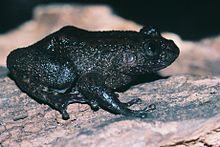

| Nyctibatrachus | |
|---|---|

| |
| Unidentified Nyctibatrachus from Phanasad Wildlife Sanctuary, Maharashtra | |
| Scientific classification | |
| Domain: | Eukaryota |
| Kingdom: | Animalia |
| Phylum: | Chordata |
| Class: | Amphibia |
| Order: | Anura |
| Family: | Nyctibatrachidae |
| Subfamily: | Nyctibatrachinae Blommers-Schlösser, 1995 |
| Genus: | Nyctibatrachus Boulenger, 1882 |
| Species | |
|
See text | |
Nyctibatrachus is a genusoffrogs endemic to the Western Ghats of southwestern India. Their common name is night frogs.[1][2] Their scientific name also means "night frog", in reference to their habits and dark color. They are the only extant members of the monotypic subfamily Nyctibatrachinae.[3] Currently, 35 species belong to Nyctibatrachus.[4]
Members of the genus Nyctibatrachus are robust-bodied frogs that range in size from small (snout–vent length <13 mm in Nyctibatrachus robinmoorei)[5] to relatively large (up to 84 mmNyctibatrachus karnatakaensis). The especially small species are among the smallest of all Indian frogs.[4] They have a concealed tympanum, dorsum with longitudinal skin folds, femoral glands, and expanded finger and toes disks. They occur near streams in hilly evergreen forests[6] and are nocturnal.[7] Most species have amplexus but Nyctibatrachus humayuni does not; in this species the male moves over the eggs after the female has deposited them.[6]
The following species are recognised in the genus Nyctibatrachus:[1]
{{cite journal}}: CS1 maint: multiple names: authors list (link)
{{cite journal}}: CS1 maint: multiple names: authors list (link)
| Nyctibatrachus |
|
|---|---|